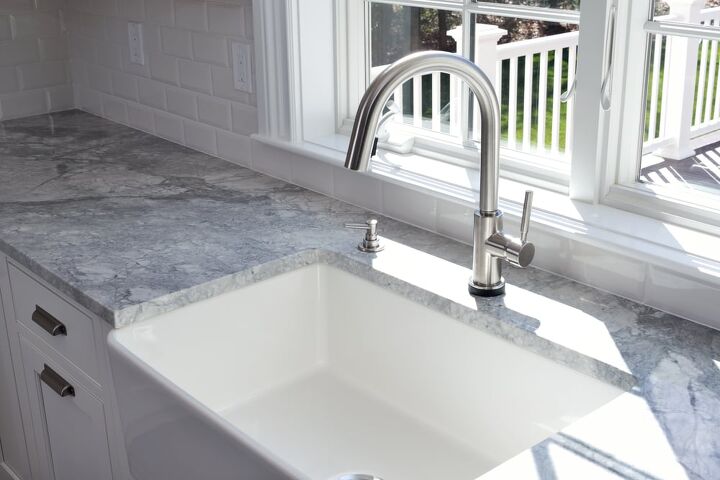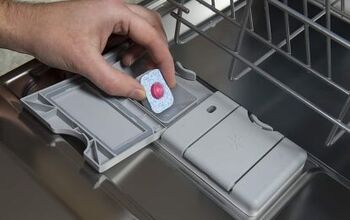Kitchen Sink Soap Dispenser Is Not Working? (We Have a Fix!)

If you’ve ever gone to my apartment, you’ll notice that I have a lot of soap. I have my dish soap and hand soaps on either side of my kitchen sink faucet. As a soap fiend, I have a major pet peeve. I can’t stand it when my kitchen sink soap dispenser stops working. Believe it or not, this is a fairly common and easy-to-fix issue. You can fit it using our advice in this article.
A kitchen sink soap dispenser that stops working is most often caused by clogs in the dispenser. Removing the soap dispenser and soaking it in warm water will remove it. Check to see if you have enough soap or if the spring is locked. If that doesn’t work, you usually have to replace the spring in the soap dispenser setup or get a new tube. If all else fails, the system’s seals are broken and you will need to replace the entire unit.
Having a built-in soap dispenser seems like it is a great upgrade until it breaks. The truth is that fixes are pretty common. Thankfully, we have all the facts behind their issues.
Do You Need a Faucet, Fixture, or Pipe Repair or Replacement?
Get free, zero-commitment quotes from pro contractors near you.

Why Isn’t My Kitchen Sink Soap Dispenser Working?
Kitchen sink soap dispensers are pesky, but in most cases, they can be fixed. Moreover, the fixes tend to stay good for a while. Let’s troubleshoot the entire thing with the most common issues first.
Check For Locks And Soap
Before you begin, make sure that you get a good look at the bare basics. First, check to make sure that you didn’t lock the soap dispenser. If the pump is twisted, untwist it 90 degrees to unlock it.
Second, make sure that there is actually soap in the dispenser system. If there’s no soap, then all you need to do is replace the soap. (It’s okay, we all run out of soap faster than we think we could. It’s totally normal.)
Clogs From Soap
Soap is great, but that doesn’t mean that it doesn’t have its own issues. The most common problem people have with soap dispensers is that they tend to clog up. When this happens, soap congeals in the piping and rig, making it impossible for stuff to push through to the dispenser. This is a pretty easy fix:
- Disconnect the cap from the soap dispenser and remove the entire rig from the sink. You may have to clean up a little bit of soap mess around the area, too.
- Grab a paper towel and wipe off the exterior. You can also use Lysol wipes, if you’re fastidious.
- Soak the entire assembly in warm water with a drop of vinegar for five to 15 minutes. This will dissolve the clog fast.
- Add the assembly back into your sink. Ta da! Finito!
Broken Springs And Kinked Tubing
By now, we are delving into the mechanical side of things. This is where you are going to have a bit of a hard time. There are two main issues that can come into play, both of which can be found by removing the dispenser assembly from the sink and visually inspecting it. The most obvious issue is the piping.
If you notice that your piping is heavily bent or has a hole in it, then you need to replace it. Thankfully, this is pretty easy to do. All you have to do is cut a length of rubber or silicon tubing of a similar size and use that as a replacement.
Springs, on the other hand, can be a bit more aggravating. Broken springs have been bent, corroded or actually snapped. To repair this, you will need to remove the old spring and find a new spring that fits the assembly you have. (Believe it or not, many store-bought soap dispensers will have something that’ll work.)
Broken Seals And Sensors
If your soap dispenser’s mechanics are totally fine and you have already cleaned out your clogs, there’s one other issue that you may have. A soap dispenser that still isn’t working may have broken seals inside the apparatus. Or, the sensor may be broken if it’s an automated model. When this happens, it’s usually not worth trying to fix things yourself. In fact, it might actually cost more and just make you pull your hair out.
Should this occur, the best thing you can do is try to buy a replacement soap dispenser for your faucet setup. We strongly suggest getting a dispenser that’s the same make and model as what you currently have. That way, you can ensure that it’ll fit correctly in the faucet setup that you have.
How Much Does It Cost To Replace A Soap Dispenser?
If you find yourself in a situation where you need to replace your soap dispenser, there is some pretty good news up ahead. There isn’t going to be a major hit to your wallet up ahead. A soap dispenser replacement only costs between $10 to $80 for most models. Luxury options can go for as much as $500, but they are rare.
If you hire a handyman to replace the dispenser, you may need to pay an additional $50. The truth is, most people do not even need to consider hiring a pro if they want to switch out their soap dispenser. This is a simple five-minute project that often comes with instructions included in the packaging. Even if you don’t get instructions, it’s usually an easy enough protect to eyeball.
How Long Should A Soap Dispenser Last?
If your soap dispenser only lasted a couple of months, you probably got sold a bad dispenser. You should be able to get at least five years out of a soap dispenser, assuming that you regularly charge it. If you have an automatic soap dispenser, then you may need to get repairs after the two-year mark simply because there are more parts that can go bad.
What Should I Do If My Luxury Automated Soap Dispenser Failed?
Let’s say that you got one of those fancy, schmancy soap dispensers that cost several hundred dollars. They are not the norm, which means that you should expect a warranty involved with them. Before you sigh and shell out hundreds more, call the company that made your dispenser.
In most cases, a quick chat with customer service will be able to get you a professional repair job from one of their licensed crews. If your dispenser is under warranty for the part you believe broke, you might also get a replacement for free.
Do You Need a Faucet, Fixture, or Pipe Repair or Replacement?
Get free, zero-commitment quotes from pro contractors near you.

Related Questions
Is an automatic soap dispenser more sanitary than a manual one?
One major reason why people prefer to get an automatic soap dispenser is that it tends to be more sanitary than manual dispensers. This is because one of the bigger contact points (the pump) is eliminated in an automated soap dispenser. It’s a good idea to invest in one if sanitation is a major concern.
What happens if you put foaming soap in a standard dispenser?
The foaming soap that you put in won’t be compatible with your dispenser. In other words, it will not foam. In some rare cases, the foaming soap may encourage clogging in the piping of your dispenser. With cases involving high-end soap dispensers, using foaming soap could potentially void the warranty. This is why we do not suggest using foaming soaps in the dispenser. Stick to dispenser-friendly options instead.
Can you use an automatic soap dispenser for hand sanitizer?
While regular hand soap and dish soap tend to be the most common materials to put inside a soap dispenser, they’re not the only ones available. You can also put hand sanitizer in a soap dispenser if you so choose. When choosing a hand sanitizer for this purpose, make sure that it’s a gel form. Liquid hand sanitizers don’t always work as well as gel forms, simply because they are harder to push up.

Ossiana Tepfenhart is an expert writer, focusing on interior design and general home tips. Writing is her life, and it's what she does best. Her interests include art and real estate investments.
More by Ossiana Tepfenhart











![10 Best Cordless Leaf Blowers – [2022 Reviews & Ultimate Guide]](https://cdn-fastly.upgradedhome.com/media/2023/07/31/9070789/10-best-cordless-leaf-blowers-2022-reviews-ultimate-guide.jpg?size=350x220)
![The 10 Best Table Saws - [2022 Reviews & Buyer's Guide]](https://cdn-fastly.upgradedhome.com/media/2023/07/31/9070645/the-10-best-table-saws-2022-reviews-buyer-s-guide.jpg?size=350x220)











![Cost To Drill A Well [Pricing Per Foot & Cost By State]](https://cdn-fastly.upgradedhome.com/media/2023/07/31/9074980/cost-to-drill-a-well-pricing-per-foot-cost-by-state.jpg?size=350x220)


